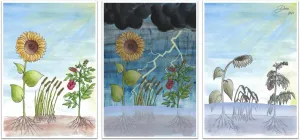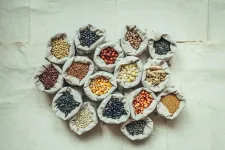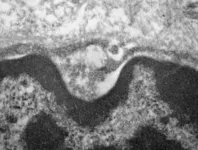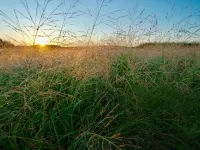(Press-News.org) Climate change is causing increased flooding and prolonged waterlogging in northern Europe, but also in many other parts of the world. This can damage meadow grasses, field crops or other plants - their leaves die, the roots rot.
The damage is caused by a lack of oxygen and the accumulation of acids. How do plants perceive this over-acidification, how do they react to it? This is what researchers from Würzburg, Jena (Germany) and Talca (Chile) describe in the journal Current Biology.
Biophysicists Dr. Tobias Maierhofer and Professor Rainer Hedrich from the Chair of Molecular Plant Physiology and Biophysics at Julius-Maximilians-Universität (JMU) Würzburg in Bavaria, Germany, were in charge of the study.
Anion channel recognises acidification
Everyone is probably familiar with the effect of over-acidification from their own experience: When exercising too hard, muscles are undersupplied with oxygen and acidosis occurs. Muscle pain and poor performance are the consequences.
"In plants, a lack of oxygen also causes acidification of the cells," says Tobias Maierhofer. The team led by the JMU researcher has now discovered the sensor in the model plant Arabidopsis thaliana (thale cress) that perceives the acidification and translates it into an electrical signal. It is a protein in the cell membrane, the anion channel SLAH3.
Super-resolution microscopy clarifies structure
Professor Markus Sauer of the JMU Chair of Biotechnology and Biophysics has developed a microscopy method that can be used to look at proteins in high resolution. With the help of his methodology, the team was able to clarify how the anion channel SLAH3 reacts during acidification.
In the non-active state, the channel is present as a complex of two subunits in the cell membrane. With a lack of oxygen, the acidity and thus the proton content in the cell increases, and protons bind to two specific amino acids of the channel.
"This protonation changes the structure of SLAH3 and the channel breaks down into its two subunits," explains Maierhofer, who is an expert on anion channels. As single copies, the two units now become conductive for anions, which leads to electrical excitation of the cell membrane.
Mutants react weaker to flooding
The electrical signal in turn triggers further reactions in the plant. Among other things, photosynthesis is reduced. "We assume that this is an adaptation to the flooding stress: the plants switch to a kind of resting state," says Maierhofer.
The JMU researchers also investigated how Arabidopsis mutants lacking SLAH3 react to flooding. These plants did not try to reduce their photosynthetic output - even though photosynthesis is not possible at all in the muddy, murky flood water where too little light reaches the leaves.
Investigating genetic control during flooding
The anion channel SLAH3 can thus convert an acidification of the cell interior directly into an electrical signal. In this way, it functions like a pH sensor.
Next, the researchers want to investigate how the electrical signal is transported in the plant and translated into a stress-avoiding response. The necessary tools for this, such as pH-insensitive mutants, are available. This makes it possible to study in detail the genetic rerouting of the physiology of plants during flooding.
The results of this basic research could prove significant for agricultural practice: "With the knowledge we are gaining, we can take a targeted approach to breed crops that are more tolerant to waterlogging," says JMU researcher Maierhofer.
INFORMATION:
For the first time, University of Basel researchers have equipped an ultrathin semiconductor with superconducting contacts. These extremely thin materials with novel electronic and optical properties could pave the way for previously unimagined applications. Combined with superconductors, they are expected to give rise to new quantum phenomena and find use in quantum technology.
Whether in smartphones, televisions or building technology, semiconductors play a central role in electronics and therefore in our everyday lives. In contrast to metals, it is possible to adjust their electrical conductivity by applying a voltage and hence to switch the current flow on and off.
With a view to future applications in electronics and quantum technology, researchers are focusing on the development ...
Abu Dhabi, UAE, July 5, 2021: NYU Abu Dhabi (NYUAD) researchers uncovered a code that sets the genome of the liver to account for the remarkable ability for this organ to regenerate. This finding offers new insight into how the specific genes that promote regeneration can be activated when part of the liver is removed. These findings have the potential to inform the development of a new form of regenerative medicine that could help non-regenerative organs regrow in mice and humans.
While other animals can regenerate most organs, humans, mice, and other mammals can only regenerate their liver in response to an injury or when a piece is removed. NYUAD researchers ...
Post-traumatic stress disorder (PTSD) rings a bell for many, due to its rampant references in pop culture, and more, importantly, its prevalence in today's society. It is only probable that this disorder, which develops after shocking or dangerous events, would unfortunately affect the lives of many people. Medical researchers have been hard at work trying to come up with solutions to combat this condition and its manifestations effectively. Unfortunately, the neurological mechanisms of PTSD aren't clear, and without knowing this exactly, trying to find a cure is a shot in the dark.
Fortunately, a group ...
"Plant a hundred kinds of crops"
Wangjinzhuang village is nestled amongst the steep slopes of the South Taihang Mountains in Hebei Province, China. To prosper in the northern climate, the villagers have developed a tried-and-true strategy: "using the land to plant a hundred kinds of crops and not rely on the sky". Their fields contain red millet, white sorghum, purple and green eyebrow beans, and yellow radishes. Having survived for over a thousand years, this agrobiodiversity is a vibrant cornerstone of the village's agricultural heritage that is too precious to lose.
In an effort to combat dwindling crop diversity across China (the Ministry of Agriculture found that of 11,590 grain crop varieties planted ...
Cardiovascular drugs do not affect COVID-19 outcomes--such as disease severity, hospitalizations, or deaths--according to an analysis of all relevant studies published as of November 2020. The findings are published in the END ...
BOSTON - Significant amounts of atherosclerotic plaque have been found in the coronary arteries of people with HIV, even in those considered by traditional measures to be at low-to-moderate risk of future heart disease, according to a study published in JAMA Network Open.
This finding emerged from the global REPRIEVE (Randomized Trial to Prevent Vascular Events in HIV) study, in which Massachusetts General Hospital (MGH) is playing a key coordinating role. Researchers found that the higher-than-expected levels of plaque could not be attributed simply to traditional cardiovascular disease risk factors like smoking, hypertension, and lipids in the blood, but were independently related to increased arterial inflammation ...
The expected decline in the number of landfills across the United States coupled with bans on disposing large amounts of organic waste in landfills that have been enacted in multiple states has prompted researchers at the U.S. Department of Energy's (DOE's) National Renewable Energy Laboratory (NREL) to examine other ways to grapple with the issue of food waste disposal.
The researchers determined no single solution exists in the United States for dealing with food waste disposal. NREL researchers Alex Badgett and Anelia Milbrandt came to that conclusion after examining the economics involved in five different ways to ...
In Brazil, researchers at the University of São Paulo’s Medical School (FM-USP) have discovered that SARS-CoV-2 infects and replicates in the salivary glands.
Analysis of samples from three types of salivary gland obtained during a minimally invasive autopsy procedure performed on patients who died from complications of COVID-19 at Hospital das Clínicas, FM-USP’s hospital complex, showed that tissues specializing in producing and secreting saliva serve as reservoirs for the novel coronavirus.
The study was supported by FAPESP and reported in an article published in the Journal of Pathology.
The researchers said the discovery ...
Bioenergy crops are an alternative energy source that, unlike fossil fuels, could positively impact the environment by reducing greenhouse gases, soil erosion, and carbon dioxide levels. They can be produced even more sustainably if they are grown on poor quality land unsuitable for food. To make up for the poor land quality, these crops can rely on soil microbes like bacteria and fungi to help them access nutrients and water and store more carbon.
Switchgrass, a native prairie species, is championed as a promising bioenergy crop due to its ability to grow across many climates. ...
BUFFALO, N.Y. - How the media frame stories about science affects the public's perception about scientific accuracy and reliability, and one particular type of narrative can help ameliorate the harm to science's reputation sometimes caused by different journalistic approaches to scientific storytelling, according to a new study led by a University at Buffalo researcher.
"What our experiment shows is that the way the news media talk about science focuses too much attention on individuals in a way that doesn't accurately describe the way science actually works," says ...




